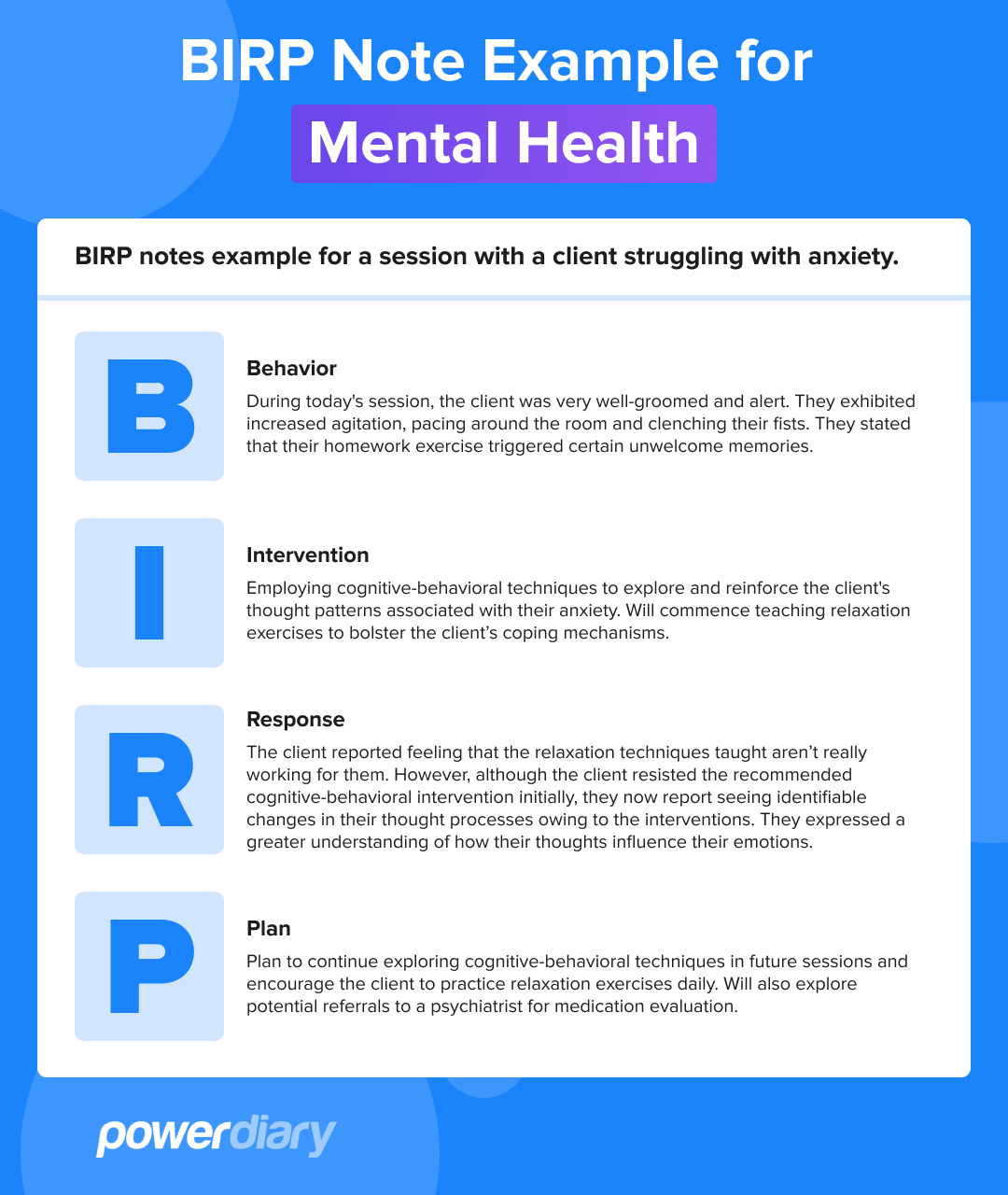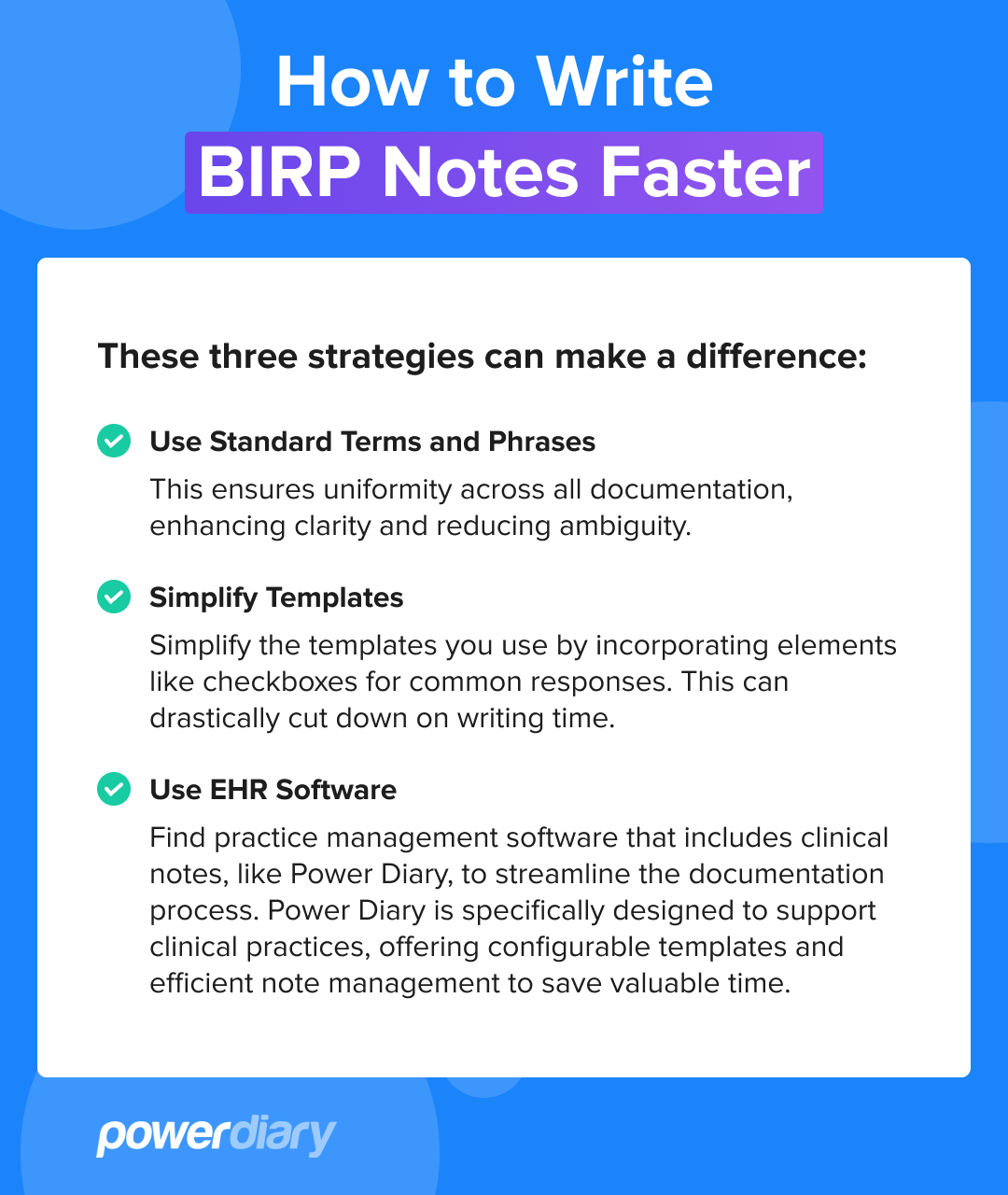Looking for a simple way to organize your session notes? BIRP notes can help you streamline your practice documentation.
BIRP notes are a structured method of documenting client or patient interactions in the mental health and counseling fields. If you’re wondering, what does BIRP note stand for? The acronym BIRP stands for Behavior, Intervention, Response and Plan.
In this article, we’ll explore what BIRP notes are and how you can write them effectively to enhance patient care.
Let’s get started!
The Components of a BIRP Note
To master BIRP notes, you must first understand each component:
Behavior
Behavior refers to observable actions or patterns exhibited by the client during a session or over a specific period. This could encompass subjective reports from the client about symptoms and feelings, as well as objective observations from you as the allied health practitioner.
This might include:
- verbal statements by the client;
- body language;
- appearance and grooming levels;
- specific actions;
- report-backs on homework.
When documenting behavior, be descriptive and objective, avoiding interpretations or judgments.
Intervention
The Intervention component outlines the action you intend to take to address the client’s identified behaviors and concerns. In this section, you’ll describe suggested strategies and techniques for addressing the client’s needs.
You should include both direct interventions during the session and any recommendations or assignments given to be implemented outside the session.
You’ll notice this section may include action-specific words.
Response
The Response section documents the client’s reactions, feedback or any changes observed due to the interventions implemented. It captures how the client engaged with the interventions and their immediate or gradual responses to the therapeutic process.
Whenever possible, include the client’s perspective to enrich the documentation.
Plan
The outcomes of the above sections should dictate the direction of the Plan section.
The Plan section outlines the next steps or recommendations based on the observed behaviors, interventions and responses.
This might include:
- strategies for ongoing treatment;
- potential intervention adjustments;
- referrals;
- additional necessary resources for the client’s progress;
- client homework.
How to Write a BIRP Note
For BIRP notes to be effective, they need to be clear, concise and coherent.
If that seems like a tricky balance to strike, we have some guidelines and tips to help you master the art of BIRP note-writing:
- Be Clear and Objective: Use straightforward language and avoid ambiguous terms or jargon. Stick to observable behaviors and concrete interventions.
- Keep It Concise: Focus on the most relevant information and avoid unnecessary details. Brevity ensures that essential points are highlighted without overwhelming the reader.
- Maintain Coherence: Structure your notes logically, following the BIRP format. Ensure that there’s a clear flow from behavior to intervention, response and plan.
Importance of Maintaining Client Confidentiality
Your BIRP notes must be comprehensive and detailed, and you’re required by law to abide by client confidentiality regulations.
Although it can be easier to ensure confidentiality with digital notes versus paper notes, you must ensure that your software is HIPAA or AHPRA-compliant and applies stringent data security and storage measures.
Practice management software like Power Diary will offer note-taking and storage solutions compliant with the most rigorous privacy and security standards.
Avoid Common Mistakes
Even the most seasoned practitioners occasionally make mistakes in their BIRP notes.
These are some of our top tips for avoiding mistakes:
- Review and Edit: Take the time to review your notes for accuracy and completeness. Double-check for any errors or omissions before finishing the documentation.
- Be Specific: To enhance clarity and accuracy, provide specific details rather than generalities.
- Don’t Wait Too Long to Draft Your BIRP Notes: It’s easier to be accurate when the session is still fresh in your mind and isn’t clouded by the details of other clients’ appointments.
- Avoid Biased Language: Remain neutral and objective in your observations and interpretations to prevent biases from influencing your documentation.
- Avoid Illegible Handwriting: If you take and store handwritten notes, ensure they’re legible to future healthcare professionals.
- Use Note-Taking Software: Good note-taking software allows users to create adjustable templates to guide the note-taker and store the notes securely.
- Use Clinical Language: Clearly describe the client’s symptoms, progress, and treatments. Avoid vague terms or colloquial interpretations.
The Role of BIRP Notes in Continuity of Care
Think of BIRP notes as bridges that connect different healthcare professionals involved in a client’s care.
BIRP Notes:
- Facilitate Communication: BIRP notes ensure that pertinent information is shared accurately and efficiently. These notes serve as a common language to describe client progress, challenges and treatment plans accurately and efficiently.
- Track Progress: By documenting behaviors, interventions, responses and plans, BIRP notes provide a record of the client’s care, enabling healthcare providers to track progress and adjust treatment plans as needed.
- Promote Collaboration: BIRP notes promote collaboration among multidisciplinary teams by providing a shared understanding of the client’s needs and goals, fostering a collaborative approach to care.
BIRP note-writing done correctly enhances the quality of documentation and contributes to positive client outcomes and continuity of care.
BIRP Note Example for Mental Health
To understand how BIRP notes look in action, here’s an example of BIRP notes for a session with a client struggling with anxiety.
Behavior
During today’s session, the client was very well-groomed and alert. They exhibited increased agitation, pacing around the room and clenching their fists. They stated that their homework exercise triggered certain unwelcome memories.
Intervention
Employing cognitive-behavioral techniques to explore and reinforce the client’s thought patterns associated with their anxiety. Will commence teaching relaxation exercises to bolster the client’s coping mechanisms.
Response
The client reported feeling that the relaxation techniques taught aren’t really working for them. However, although the client resisted the recommended cognitive-behavioral intervention initially, they now report seeing identifiable changes in their thought processes owing to the interventions. They expressed a greater understanding of how their thoughts influence their emotions.
How to Write BIRP Notes Faster
To accelerate the process of writing BIRP notes, these three strategies can make a difference:
Use Standard Terms and Phrases
This ensures uniformity across all documentation, thereby enhancing clarity and reducing ambiguity.
Simplify Templates
Simplify the templates you use by incorporating elements like checkboxes for common responses. This can drastically cut down on writing time.
Use EHR Software
Find an EMR software that includes clinical notes, like Power Diary, to streamline the documentation process. Power Diary is specifically designed to support clinical practices, offering configurable templates and efficient note management to save valuable time.
What’s the Difference Between SOAP Notes & BIRP Notes?
SOAP (Subjective, Objective, Assessment, Plan) notes and BIRP (Behavior, Intervention, Response, Plan) notes are both commonly used note-taking formats in allied health.
Here are the distinctions between the two formats:
SOAP Notes: Subjective, Objective, Assessment, Plan
Like BIRP notes, SOAP notes guide allied health note-taking by breaking down complex information into simple, sequential parts.
SOAP stands for Subjective, Objective, Assessment and Plan – here’s what each section requires:
- Subjective: This section includes the client’s self-reported information, such as symptoms, feelings, and concerns, as communicated during the session.
- Objective: The Objective section consists of observable and measurable data, including vital signs, physical examination findings, displayed behaviors, and any other objective assessments made by the practitioner.
- Assessment: Here, the practitioner interprets the subjective and objective information to formulate a diagnosis or assessment of the client’s condition.
- Plan: The plan outlines the proposed interventions, treatments, or actions to address the client’s needs and achieve therapeutic goals.
How BIRP Notes Differ from SOAP Notes
While both SOAP and BIRP notes serve as tools designed to streamline documentation in healthcare, they differ slightly in their structure and focus.
Here’s how:
- Structure: SOAP notes progress from Subjective to Objective data, Assessment and Plan. In contrast, BIRP notes follow a different structure, focusing on Behavior, Intervention, Response and Plan.
- Focus: SOAP notes emphasize the diagnostic process, with a detailed assessment section where practitioners interpret data and formulate diagnoses. BIRP notes, on the other hand, focus more on documenting specific behaviors observed during the session, interventions implemented, client responses and future plans for treatment.
- Circumstance-Based Applications: Because SOAP notes tend to focus more on assessment and diagnosis, there is an argument that they’re more appropriate for use in long-term therapy, whereas the BIRP note format might be better suited to client scenarios that require more urgent action.
Why a Practitioner May Choose One Over the Other
Whether you prefer the SOAP or BIRP note format will depend largely on your practice focus. A more diagnosis-focused approach may lean more heavily on SOAP note-taking, while a practice that’s more intervention-focused might lean towards BIRP notes.
SOAP and BIRP notes serve as valuable tools for healthcare documentation. Practitioners tend to select the format that best aligns with their clinical needs, preferences and the specific requirements of their practice setting.
What’s the Difference Between DAP Notes & BIRP Notes?
Another commonly used note format is DAP notes. DAP stands for Data, Assessment and Plan.
How do they differ?
DAP Notes: Data, Assessment, Plan
- Data: This section comprises factual information collected during the session, including observations, test results, and client statements.
- Assessment: Here, the practitioner analyzes the data collected to formulate an assessment or diagnosis of the client’s condition or progress.
- Plan: The plan section outlines the proposed interventions, treatments or actions to address the client’s needs and achieve therapeutic goals.
How BIRP Notes Differ from DAP Notes
While both BIRP and DAP notes serve as documentation tools in healthcare, they differ in their structure and focus.
Here’s how:
- Structure: DAP notes progress from Data collection to Assessment and Planning. In contrast, BIRP notes follow a different structure, focusing on Behavior, Intervention, Response and Plan.
- Focus: DAP notes emphasize the collection and analysis of data to inform assessment and planning. BIRP notes, on the other hand, focus more on documenting specific behaviors observed during the session, interventions implemented, client responses and future plans for treatment.
Why a Practitioner May Choose One Over the Other
Some practitioners may prefer DAP notes for their structured approach to data collection and assessment, while others may find BIRP notes more suitable for documenting therapeutic interactions and treatment progress.
Both DAP and BIRP notes serve as valuable tools for healthcare documentation, and practitioners may select the format that best aligns with their clinical needs, preferences and the specific requirements of their practice setting.
BIRP Note Cheat Sheet
Here’s our checklist of what to include and consider when drafting your BIRP notes:
Behavior
✅ Record subjective observations: These include things the clients report feeling. Sometimes it’s useful to include direct quotes here.
✅ Record objective observations: Describe specific behaviors and observable symptoms exhibited by the client during the session.
✅ Avoid Interpretations: Don’t add interpretations to your observations. Use clinical language and avoid judgemental tones.
✅ Be Descriptive: Use clear and concise language to depict the client’s behaviors accurately.
Intervention
✅ Therapeutic Strategies: Document the interventions or techniques you implemented during the session.
✅ Include Client Participation: Highlight the client’s involvement in the intervention process.
✅ Avoid Generalizations: Be specific about the interventions used and their intended outcomes.
✅ Have You Used Action-Oriented Language in Your Descriptions? BIRP note examples include encouraged, reinforced, recommended, taught, demonstrated, modeled, supported, or bolstered.
Response
✅ Client Feedback: Record the client’s reactions, responses, or changes observed after the interventions.
✅ Include Client’s Perspective: Incorporate the client’s own insights and perceptions whenever possible. How does the client feel about the interventions used?
✅ Track Progress: Note any improvements, setbacks or changes in the client’s condition.
Plan
✅ Future Recommendations: Outline the proposed plan for future sessions or interventions.
✅ Include Collaborative Decisions: Document any decisions made collaboratively with the client.
✅ Referrals or Additional Resources: Mention any referrals to other healthcare professionals or recommendations for further support.

Conclusion
BIRP notes offer benefits for healthcare professionals and clients alike. They facilitate clear communication, track progress and promote collaboration among multidisciplinary teams.
Thinking of streamlining your documentation to enhance your practice? With its user-friendly interface and comprehensive features, Power Diary simplifies the task of writing BIRP notes and managing client records.
Start your journey towards more efficient and effective documentation today by signing up for a 14-Day Free Trial of Power Diary. No credit card required.







